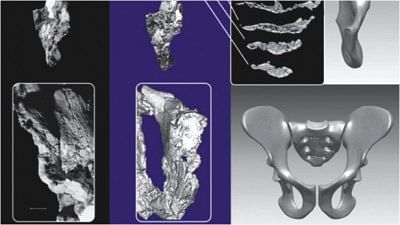Who was Ardi?

Original and reconstructed pelvis of Ard's partial skeleton -- an early human who lived 4.4 million years ago -- may suggest that humans did not evolve from chimpanzee-like ancestors.
It seems man's oldest known ancestor is in a severe identity crisis. "Ardi," or Ardipithecus ramidus, a supposed ancestor of man. who was considered to be a scientific breakthrough of the Year 2009 by both Science as well as Time magazine is now subject to a new scientific scrutiny. Researchers are genuinely expressing doubts about where the creature exactly came from, along with questioning whether Ardi truly belonged to the human branch of the evolutionary tree at all. Previously it was believed that the 4.4 million-year-old fossil found in Ethiopia in 1992, used to roam as a creature in the dense woodlands of Africa. But in a new article titled "Comment on the Paleo-biology and Classification of Artipithecus ramidus", authored by Dr. Esteban Sarmiento, a primatologist at the Human Evolution Foundation, that was published in the latest edition of journal Science, two critical issues have been raised. The first one is, based on isotopic data from soils, plants and animals; it is now suspected that the species habitat was likely to be a more open savannah with trees rather than woods. And the second concern is more startling which states that A. ramidus is more ape-like than human. It must be mentioned here that Ardi, standing 4 feet (120 cm) tall and weighing 110 pounds (50 kg), was discovered by anthropologist Dr. Tim D. White and remains the oldest known hominid fossil. In fact "Ardi" is more primitive than the well-known Australopithecine skeleton, "Lucy", which was also discovered in Ethiopia back in 1974.
According to Dr. Sarmiento, many of the physical traits used by Dr. White to place Ardi on the human lineage are also shared by other primates. He further argued that the specific anatomical features of teeth, the skull and elsewhere that the White's team of researchers cited just don't make a convincing case for Ardi's membership on the human branch. The biggest mistake that Dr. White made, according to the paper, was to use outdated characters and concepts to classify Ardi and the failure to identify the anatomical clues that would rule out the creature as a human ancestor. Naturally Dr. White stood by his findings and disagreed with Dr. Sarmiento's conclusion as he stated that "The evidence is very clear that in Ardipithecus, there are characteristics shared only by later hominids…and humans". But Dr. Sarmiento's points of views were echoed by eight other world renowned geologists and anthropologists from seven different universities. Most of these distinguished scientists painstakingly studied the ancient soils and other geological and environmental indicators of the African hominid sites. And as technical commentaries these critiques of Dr. White's findings conclude that Ardi most likely lived in tree or bush savanna with 5% to 25% of the area covered by trees or shrubs, not the minimum 60% to meet the definition of closed-canopy woodland. And this leads to savanna hypothesis which states that an expansion of savannas-grassy plains dotted with trees and shrubs-prompted ape-like ancestors of humans to descend from the trees and start walking upright to find food more efficiently. According to both Prof. Thure E Cerling and Prof. Francis H. Brown, noted geophysicists from University of Utah, "One of the big, newsworthy items that White and coworkers put forward is that Ardipithecus walked upright on two legs, yet lived in a forested environment.
They then say the savanna hypothesis, which holds that the reduction in forest cover in Africa is one of the reasons for early man becoming bipedal must be incorrect". The academicians conclude that much of the evidence that Dr. White and his colleagues present regarding Ardi should be interpreted as a savanna environment and therefore their (White and colleagues) rejection of the savanna hypothesis is incorrect. But Dr. White and his team are relentless as the group that discovered Ardi at the first place stated that Sarmiento's "tortuous, non-parsimonious evolutionary pathways" are not supported by many of the fossil's characteristics. So, who's right and who's wrong? Perhaps only Ardi can tell!

 For all latest news, follow The Daily Star's Google News channel.
For all latest news, follow The Daily Star's Google News channel. 



Comments